Teeth Straightening
Perfectly aligned teeth not only deliver a captivating smile and high self-confidence, but the correct biting pattern evenly deploys pressure when eating, thus reducing the stress on the jaw. Teeth misalignment (malocclusion) is a relatively common health problem and can take many forms.
Besides aesthetic reasons, getting your teeth properly straightened protects them from grinding wear and tear, overstressed temporomandibular joint and most importantly, a correct biting pattern.
Teeth straightening (orthodontic treatment) can alleviate and prevent future dental problems as straight teeth are easier to clean, thus reducing the risk of cavities and periodontitis.
What is orthodontics?
Orthodontics (also referred to as dentofacial orthopedics) is a specialized form of dentistry which focuses on diagnosing, treating and preventing dental and facial abnormalities. The dental specialists in this field are called orthodontists.
When to get a teeth straightening treatment?
Ideally, teeth straightening treatment starts around the age of 12 when the primary teeth are replaced with permanent ones. However, adults can also benefit and have their teeth straightened later in life, especially when the wisdom teeth erupt.
With regular dental checkups, the dentist can identify if there’s a problem with the position of the teeth inside the child’s jaw and recommend adequate treatment options.
Our teeth straightening services provide you with several options for braces:
- Invisible braces (Invisalign and lingual braces),
- Removable fast braces (Inman aligner),
- Tooth-coloured traditional braces.
Types of malocclusion
In neutral occlusion, the teeth are well aligned, with the lower teeth being only 1-2mm behind the upper teeth. All teeth have contact with each other. Neutral occlusion can occur in combination with crowding, with gaps or a protrusion of the teeth and all of this kind of inaccuracy can be corrected.
Overcrowding
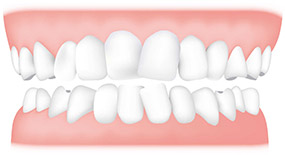 This occurs when your jawbone is too small for all of your teeth be properly positioned. Overcrowding is the most common type of malocclusion. It occurs when there is a discrepancy between the size of the teeth and the available space for proper alignment, or because of premature extraction of a primary tooth. Sometimes, it can occur later in life, when the wisdom teeth begin to erupt. It’s the most common reason for orthodontic treatment among adults.
This occurs when your jawbone is too small for all of your teeth be properly positioned. Overcrowding is the most common type of malocclusion. It occurs when there is a discrepancy between the size of the teeth and the available space for proper alignment, or because of premature extraction of a primary tooth. Sometimes, it can occur later in life, when the wisdom teeth begin to erupt. It’s the most common reason for orthodontic treatment among adults.
Possible consequences: There’s an increased risk of dental cavities since it is very difficult to clean the teeth as well as inflammation of the gums and gum recession.
Overjet
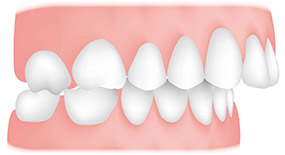 An overjet is where your top teeth extend past your bottom teeth horizontally (not to be confused with an overbite). Protruding teeth can risk damage and cause problems with eating and speech.
An overjet is where your top teeth extend past your bottom teeth horizontally (not to be confused with an overbite). Protruding teeth can risk damage and cause problems with eating and speech.
Overbite
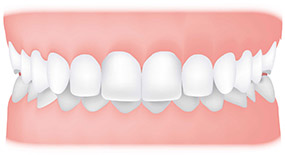 Overbite is a very common type of malocclusion. In this case, the lower jaw is too far back (or too narrow), creating a large gap between the upper and the lower teeth.
Overbite is a very common type of malocclusion. In this case, the lower jaw is too far back (or too narrow), creating a large gap between the upper and the lower teeth.
Possible consequences: The incisors of the lower jaw can grow into the gums and injure the palatal mucosa; the risk of injury to the incisors (e.g. during physical activity) is significant, as the lips are not in a position to protect the teeth.
Additionally, the dental arches collapse because they do not support each other. In case of an overbite, the temporomandibular joint (TMJ) is subject to excessive stress. The result can be considerable pain, clicking, and reduced function.
Crossbite
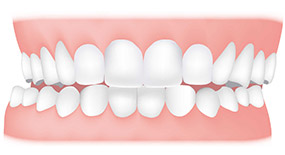 A crossbite can occur on either side (left or right), or even in the front teeth. In this case of malocclusion, you could experience bone loss, excessive tooth wearing, and periodontitis. In a lateral crossbite, the lower molars protrude over the upper molars.
A crossbite can occur on either side (left or right), or even in the front teeth. In this case of malocclusion, you could experience bone loss, excessive tooth wearing, and periodontitis. In a lateral crossbite, the lower molars protrude over the upper molars.
Possible consequences: Crossbite can lead to asymmetrical facial development. If left untreated over the years, a one-sided crossbite can lead to a deformed growth of the lower jaw toward the crossbite side while overstressing the TMJ – resulting in considerable pain, diminished function and other oral health problems like inflammation of the periodontal tissues.
Anterior crossbite (underbite)
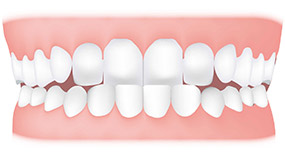 A crossbite that affects the front teeth is known as an anterior crossbite, or perhaps more commonly as an underbite.
A crossbite that affects the front teeth is known as an anterior crossbite, or perhaps more commonly as an underbite.
In the case of underbite malocclusion, the lower front teeth that protrude beyond the upper teeth, which can cause stress on the lower teeth and TMJ-related problems.
Possible consequences: The edges of the front teeth close together, edge on edge. This malocclusion leads to considerable attrition and erosion of the tooth enamel. As with overbites, underbites cause excessive stress to the TMJ. This can result in considerable pain, clicking and TMJ function, gaps between the teeth and gum recession.
Gaps between teeth (Spacing)
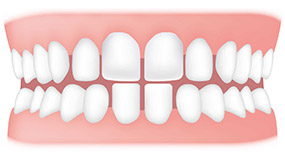 Spacing can occur between two or more teeth. Some of the causes can include missing teeth, small teeth or a wider jaw, tongue thrusting and thumb sucking.
Spacing can occur between two or more teeth. Some of the causes can include missing teeth, small teeth or a wider jaw, tongue thrusting and thumb sucking.
Sometimes, these gaps can be camouflaged with aesthetic fillings, but in most cases, orthodontic treatment is required before aesthetic restorations can be made.
Diastema
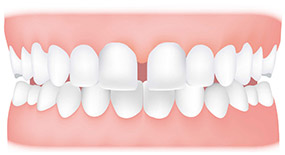 A diastema is a space between two teeth, usually the front teeth. This type of malocclusion is very popular at present-day. Eddie Murphy, Samuel L. Jackson, Madonna, Georgia May Jagger, Brigitte Bardot and many other celebrities have it.
A diastema is a space between two teeth, usually the front teeth. This type of malocclusion is very popular at present-day. Eddie Murphy, Samuel L. Jackson, Madonna, Georgia May Jagger, Brigitte Bardot and many other celebrities have it.
Impacted tooth
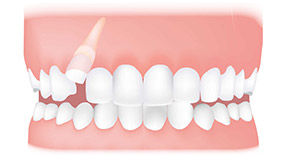 An impacted tooth is one that’s unable to erupt through the gum normally.
An impacted tooth is one that’s unable to erupt through the gum normally.
Possible treatments include removing the tooth, or exposing it so that a brace can be fitted.
Missing tooth
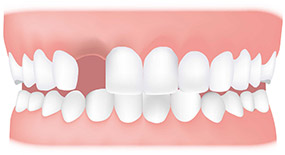 Missing teeth, or hypodontia, can occur as a result of teeth not developing properly or through trauma.
Missing teeth, or hypodontia, can occur as a result of teeth not developing properly or through trauma.
Gaps due to tooth loss should be promptly restored, since otherwise the adjacent teeth may tilt into the gap, and also the antagonist tooth can elongate into the empty space.
Open bite
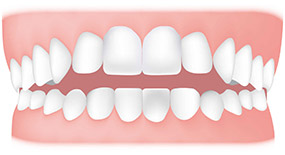 Open bite malocclusion occurs when some of the upper and lower teeth cannot make contact when your mouth is closed. This can lead to significant problems with chewing.
Open bite malocclusion occurs when some of the upper and lower teeth cannot make contact when your mouth is closed. This can lead to significant problems with chewing.
Possible consequences: Due to the vertical growth of the lower jaw the face may appear elongated. An open bite can cause a considerable amount of stress on the TMJ which can result in moderate to severe pain, clicking and TMJ function. Moreover, the chewing ability is significantly hindered.
Teeth straightening options
Invisalign – Discreet and invisible. Invisalign allows you to straighten your teeth with a series of removable clear retainers. Treatment times range from 1 year to 2 years.
Tooth coloured braces – The majority of our braces options for adults are now metal-free. We use ceramic braces and bone coloured wires to make the braces seamlessly blend in with your smile.
Invisible lingual braces – Our lingual braces are totally invisible and are fixed to the back of your upper and lower front teeth. No one, except your dentist, will even suspect that you are undergoing teeth straightening treatment.
FAQ about Teeth Straightening
Straightening your teeth
Orthodontics (also referred to as dentofacial orthopedics) is a specialized form of dentistry which focuses on diagnosing, treating and preventing dental and facial abnormalities.
The first orthodontic examination is recommended at the age of 7. By this time, several permanent teeth in most children have already erupted, allowing us to evaluate their orthodontic condition.
There are five essential questions which are covered during the initial orthodontic examination:
- Is there an orthodontic problem? And if so, what kind of malocclusion is it?
- What steps should be taken to address the problem?
- Would tooth extraction be necessary?
- How much time is the treatment going to take?
- How much is the treatment going to cost?
Straight teeth and a balanced facial profile are the goals of orthodontics. In some cases, a tooth extraction may be necessary in order to achieve this goal. However, the advancement of technology has provided orthodontists with comprehensive treatment options, thus minimizing the need for extracting teeth is not always necessary for orthodontic treatment.
Treatment time depends on a variety of factors such as the nature and severity of the orthodontic problem. Every patient reacts differently to the therapy and his or her cooperation is crucial for a successful treatment. In general, active treatment ranges from 6 to 30 months. An average treatment lasts for approximately 22 months.
The exact costs for the orthodontic treatment can only be calculated during the initial examination, where the dental specialist is going to explain the available options to accommodate your budget and needs.
There might be some discomfort during the initial stages of the treatment and the teeth may feel sore for a few days. Pain medications will ease the discomfort. However, It can take some time for your teeth, gums, cheeks, lips, and tongue to get used to the new condition.
A short medical history, X-ray images and impressions from the upper and lower jaw are required before the braces can be fitted. After these things are provided, the orthodontist is going to form and put a treatment plan in place.
Patients should brush their teeth at least four times each day – after each meal and before going to bed. Brushing your teeth regularly will help remove any food residue that may be trapped between the teeth and the braces.
You should also floss daily to get in between your teeth where your brush is unable to reach. Our dentists will show you how to properly brush and floss your teeth. The use of additional products is recommended (pastes, mouthwashes, special brushes), if necessary.
Once treatment begins, the orthodontist will provide you with instructions and a comprehensive list of foods that should be avoided.
For example, foods that contain a lot of sugar (to prevent cavities), sticky foods (i.e. caramel, gummy bears, chewing gums), hard foods (hard candy, nuts, ice cubes). Additionally, avoid biting off raw vegetables as well as food that could possibly get stuck in your braces (popcorn).
No patient is ever “too old” to wear braces. Health, happiness, and self-esteem are equally important to adults as well as children. Multiple treatment options are now available to address adults’ specific orthodontic problems and aesthetic concerns.
Yes. A tooth with a crown will move just like a tooth with a simple filling. When teeth are missing due to extraction, the orthodontic treatment will in fact aid in the alignment of the remaining teeth.
No, they can not. The available space for the front teeth doesn’t increase as you grow. In most cases, after the permanent molars erupt, the available space for the front teeth decreases with age.
Orthodontic appliances may be removable or fixed (brackets bonded to the teeth). By placing a constant, gentle pressure in a carefully controlled direction, the braces slowly move teeth into the correct position.

